Toulouse have been struggling in Ligue 1 this season. They’re dead last, having collected merely 13 points from winning three games, drawing four, and losing an outstanding amount of 21 games. It’s certainly a spectacular tally, though not spectacular in a good way. Their performances this season have undoubtedly been poor. They’re both the least prolific team (22 goals scored) and have the most goals conceded (58 goals conceded). And just before the postponement of Ligue 1, they were on a six-game losing streak and to make it more painful, they also haven’t won a single game from week 11 until week 28.
This is rather strange considering they have a couple of highly talented players in the team. One of them being Bafodé Diakité. The 2001-born centre-back has been showing impressive development as well as interesting displays this season having been promoted from Toulouse U19 and made his debut last season. Though he was struggling with a couple of injuries this season, he’s always able to regain fitness quickly and get back to the starting lineup as soon as possible.
At 19 years old, Diakité is already a vital member of the first-team and he may certainly be significantly important in the future if Toulouse can keep hold of him.
In this tactical analysis/scout report, we’ll take a closer look at Diakité’s abilities and how he plays in Toulouse’s tactics.
Physicality and athleticism
Looking at the way he plays, Diakité relies a lot on his physicality and athleticism both in attack and defence, though his contributions are most visible in defence. Diakité is 1.85 m (6’0″) tall and has a medium build, not too muscular nor skinny. He seems to have decently developed upper and lower muscles.
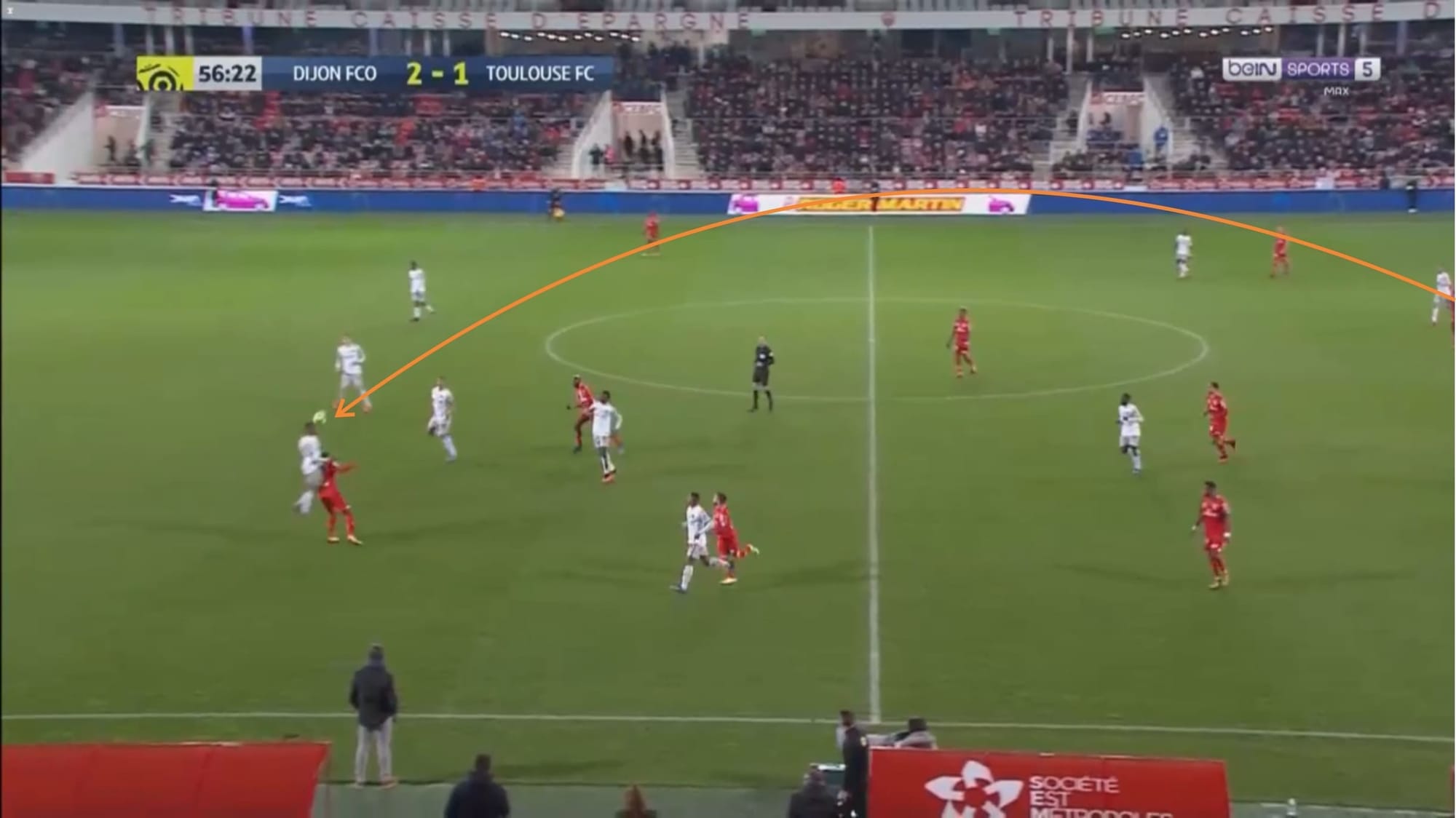
Diakité is particularly strong in aerial duels. He may not be a towering defender but his height is good enough to help him reach good vertical height when leaping, especially when combined with the power he has in his lower body. And when engaging in physical duels both in the air and on the ground, his impressive strength gives him great advantages as not only he can push his opponent(s) away and connect his head with the ball when in the air but he can be a difficult man to contain when on the ground.
Diakité can be quite aggressive and physical when duelling for the ball, using his strong body and limbs to gain an edge and make it difficult for his opponent to make perfect contact with the ball.
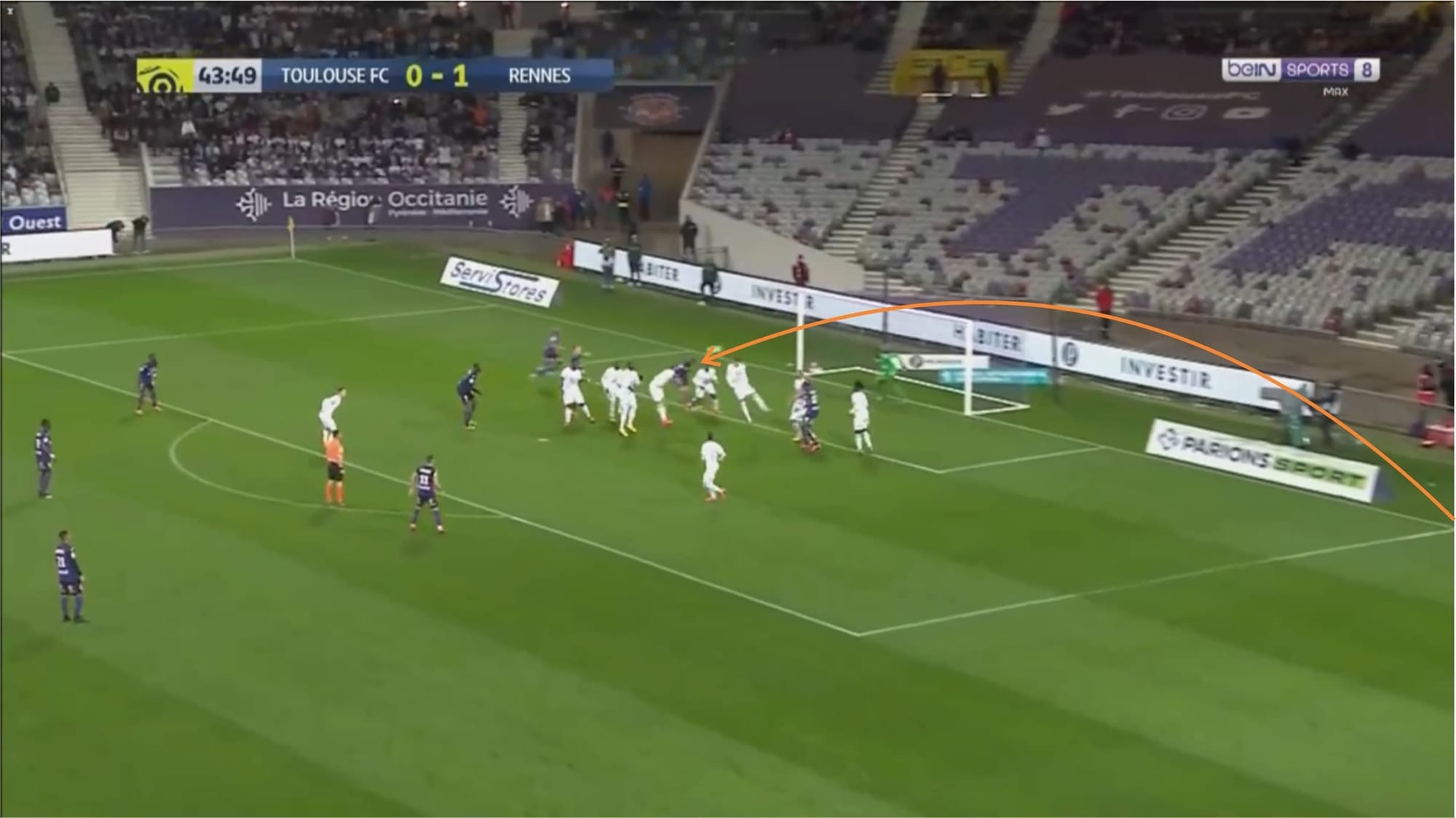
His impressive aerial ability makes him not only a useful player in defence but also a threat in attacking situations – especially attacking set-piece situations.
Aside from using physicality, athleticism, and aggression when duelling for the ball, his ability to direct the ball and generate great power in his headers are also very good. Not only because of his physicality and athleticism, but his technique is also good. He has got strong neck muscles and when coupled with perfect contact and technique, this can be a very good weapon to use in attack. In the corner situation above, for example, Diakité managed to get his head to the ball and make perfect contact to generate a powerful and accurate header although the opposing goalkeeper still managed to get his hands to parry the ball away.
According to stats from Wyscout, Diakité makes an average of 3.59 aerial duels per game with only a 50.7% success rate which is decent but not highly impressive. The low amount of aerial duels can be attributed to the fact that he tends to stay in his spot and rarely gets out of position to challenge for aerial balls if an opponent is launching a long ball forward, relying on his teammates to win the aerial challenge instead. And though he has good physicality, athleticism, aggression, perhaps his anticipation is something he still needs to work on. A lot of times Diakité can be seen missing the ball due to misjudging the flight of the ball or mistiming his jump thus contributing to the amount of success rate he currently has. Surely if he can improve this area, he may be able to be a much more effective and solid defender and attacker when it comes to aerial balls.
His great strength also helps him a lot on the ground both on and off the ball. Out of possession, Diakité is able to outmuscle many opponents when jostling, especially against smaller opponents. Players with similar or larger build won’t have an easy time going against him too as he’ll always give them some trouble. Diakité’s strength and aggressive approach often can annoy his opponents, forcing them to take a decision that they’re not supposed to or don’t want to take.
The young Frenchman averages around 4.99 defensive duels per game with a pretty impressive success rate of 65.6%, showing just how proficient he is in defensive 1v1 situations.
Meanwhile, on the ball, Diakité is able to use his body well to protect the ball. Again, due to his strength, he’s not easy to contain and push off the ball so engaging in a physical duel to try and win the ball from him may be less effective. Diakité, however, has rather limited ability on the ball, thus just shadowing him and waiting until he makes a mistake and nicks the ball away when there’s momentum and opportunity to do so are much more effective and efficient against him.
Diakité averages 2.04 offensive duels per game with a low success rate of 36.8%. The low amount of attempts is simply due to his tendency not to take on an opposing player when on the ball although at certain times and situations he will be forced to do so. Meanwhile, the unimpressive success rate indicates his inability to beat his man and retain possession when on the ball mainly due to his limited technique on the ball which will be talked about more later in this tactical analysis/scout report.
Aside from his strength, Diakité has pretty decent overall quickness. He’s not particularly sharp, especially over short-range, but he’s certainly not sluggish either.
Diakité has fairly decent acceleration. He’s able to start his run and then reach his top speed pretty quickly. This can be pretty useful for him as he can quickly cover space, close down opponents, or keep up with an opponent in a 1v1 situation. He’s, however, not the quickest of players thus highly explosive opponents can still beat him in a foot race. His medium or long-pace is not bad either. This can be seen as he can cover large distances (usually when tracking back) pretty quickly.
Diakité also has a fairly decent agility and balance. He’s able to turn and change directions pretty quickly and effectively from a standstill or when he’s on the move without needing to take one or two extra steps and ultimately lose momentum when doing so. Diakité’s agility is particularly visible when he’s off the ball especially when combined with his speed. This can be quite useful especially in defence as he can often keep up with his opponents’ movements or quickly change directions to close down or catch up with an opposing player or even intercept a ball coming into certain areas. However, strangely, on the ball he seems rather stiff. This will be explained later in this tactical analysis/scout report.
On-the-ball ability and distribution
Diakité has rather limited technical proficiency when on the ball, especially when it comes to ball control and dribbling. As mentioned before, he may struggle to keep the ball when under pressure or in 1v1 situations not because he lacks strength and can be outmuscled or he’s unable to shield the ball well, but mainly due to the lack of variety of techniques he can execute when on the ball. This is mainly why Diakité very rarely dwells on the ball and most often choose to immediately play the ball towards his teammate after receiving a pass, usually taking only one or two touches when on the ball. This is also why Diakité tends not to drive forward into space to exit pressure, mainly choosing to force a pass into the feet of a teammate instead.
When receiving the ball, his first touch is actually not bad. He’s usually able to control the ball well but sometimes a difficult ball may cause him to struggle to control the ball comfortably. A pass that’s too sharp for example, may cause a heavy touch from him.
He’s able to use either foot to receive the ball though he’s much more comfortable receiving with his right. He likes to receive the ball with the inside of his back foot and rarely receives with his sole or outer foot. Upon having the ball played towards him, he’ll try to receive with an open shape to allow a better perception of the pitch. As mentioned before, upon receiving, he’s likely to take only one or two extra touches before passing the ball towards his teammate.
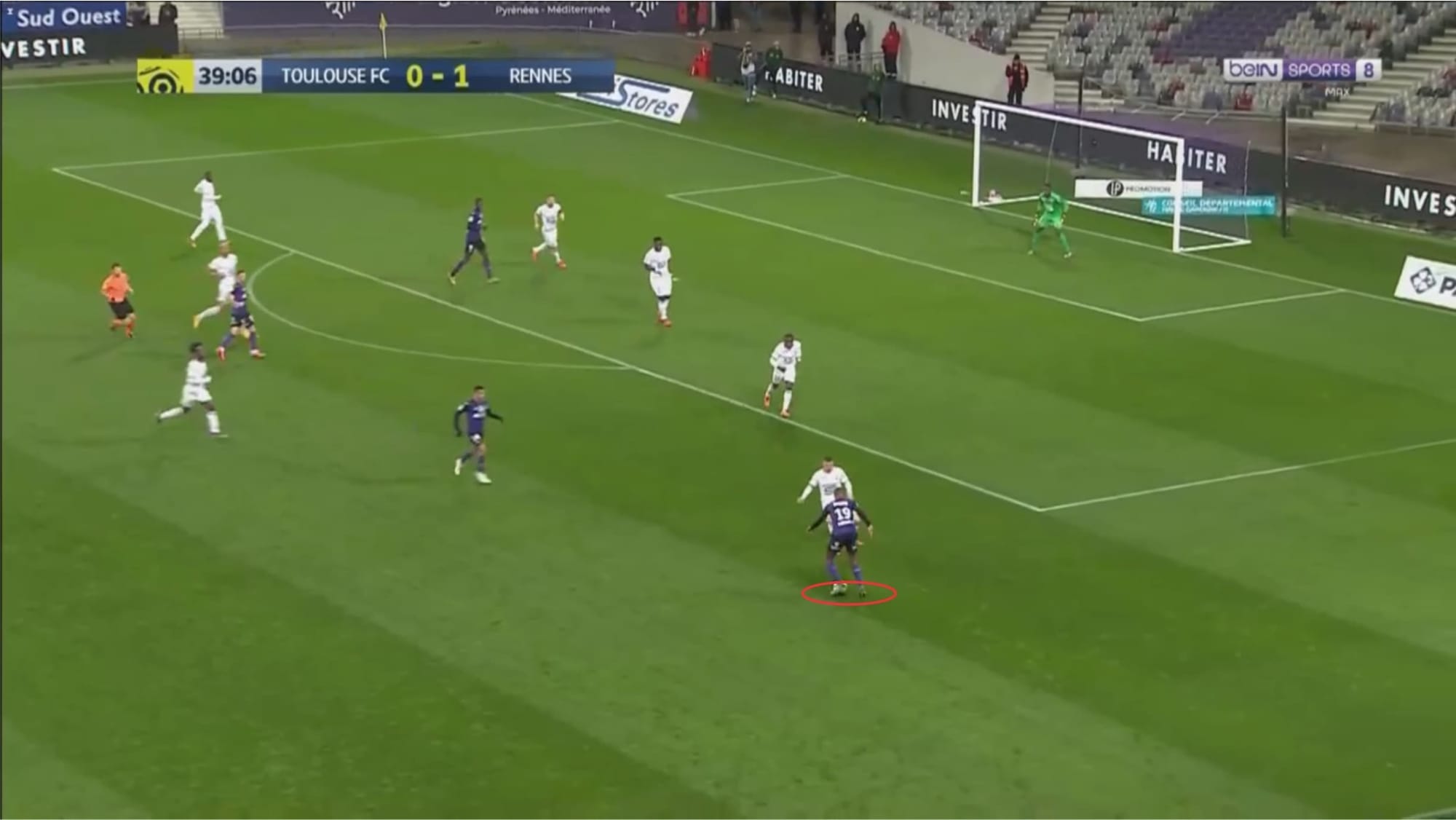
Diakité doesn’t always find himself in 1v1 offensive situations and rarely takes on an opposing player unless he’s forced to. As mentioned earlier, he also tends to move the ball quickly after receiving, thus avoiding pressure and avoiding these 1v1 situations knowing that there’s a big risk that he could lose the ball if he decides to take on an opposing player or drive forward with the ball.
The main problem is, as mentioned before, his limited technique on the ball. That coupled with his lack of flair and creativity on the ball, clearly displays his weakness in this particular area.
What can also be seen in these situations is his lack of composure. Diakité seems uncomfortable receiving pressure, especially without support near him, making him a good target to press and force to make a mistake. Often when pressed and isolated at the back, instead of trying to beat his man and drive forward with the ball, Diakité would choose to play the ball back to the goalkeeper instead.
It has been mentioned in the previous section in this tactical analysis/scout report that Diakité’s body when on the ball is rather stiff, whether it be when he’s dribbling or in static 1v1 situations like the example in the image above. He rarely attempts feints and his stiff posture when on the ball tends to give him disadvantages as it reduces his flexibility and helps the opposing player read his movements easily.
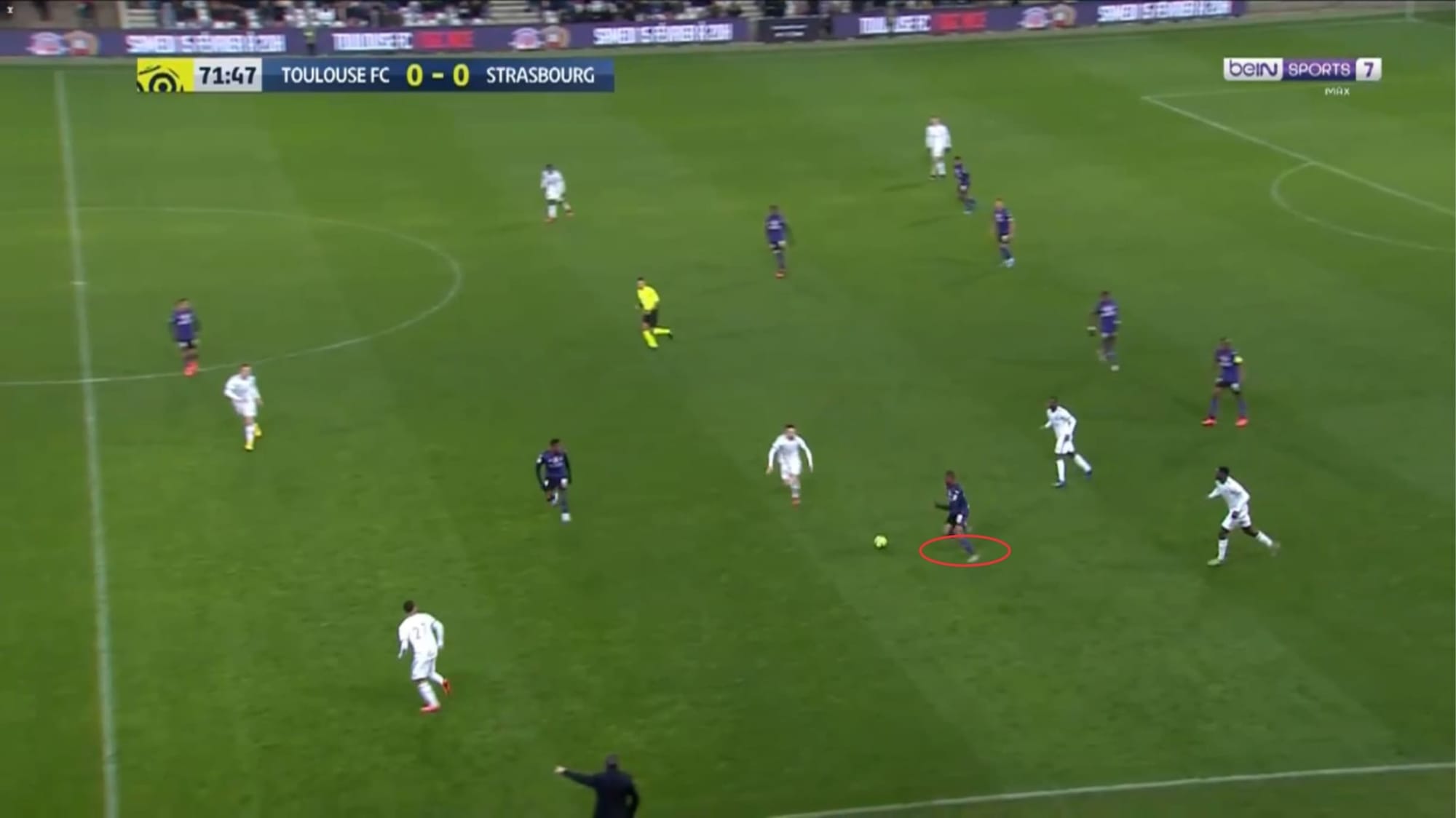
Though his touch when receiving the ball is not bad, when dribbling he seems to lack the ability to control the ball properly. When dribbling, Diakité is much more comfortable leading the ball with his right foot though occasionally he can be seen switching to his left as well. Often when dribbling, Diakité knocks the ball too hard and loses control just like in the image above.
Diakité averages only 0.7 dribbles per game with a success rate of 53.8% which proves his weakness in this particular area and his tendency not to dribble the ball but instead pass it towards a teammate. He also averages 0.54 progressive runs this season which makes perfect sense, linking back to his tendency not to drive forward even when given space and opportunity.
When it comes to distribution, Diakité is certainly not perfect yet and there are still a lot of aspects to improve but he already shows pretty decent ability at the moment.
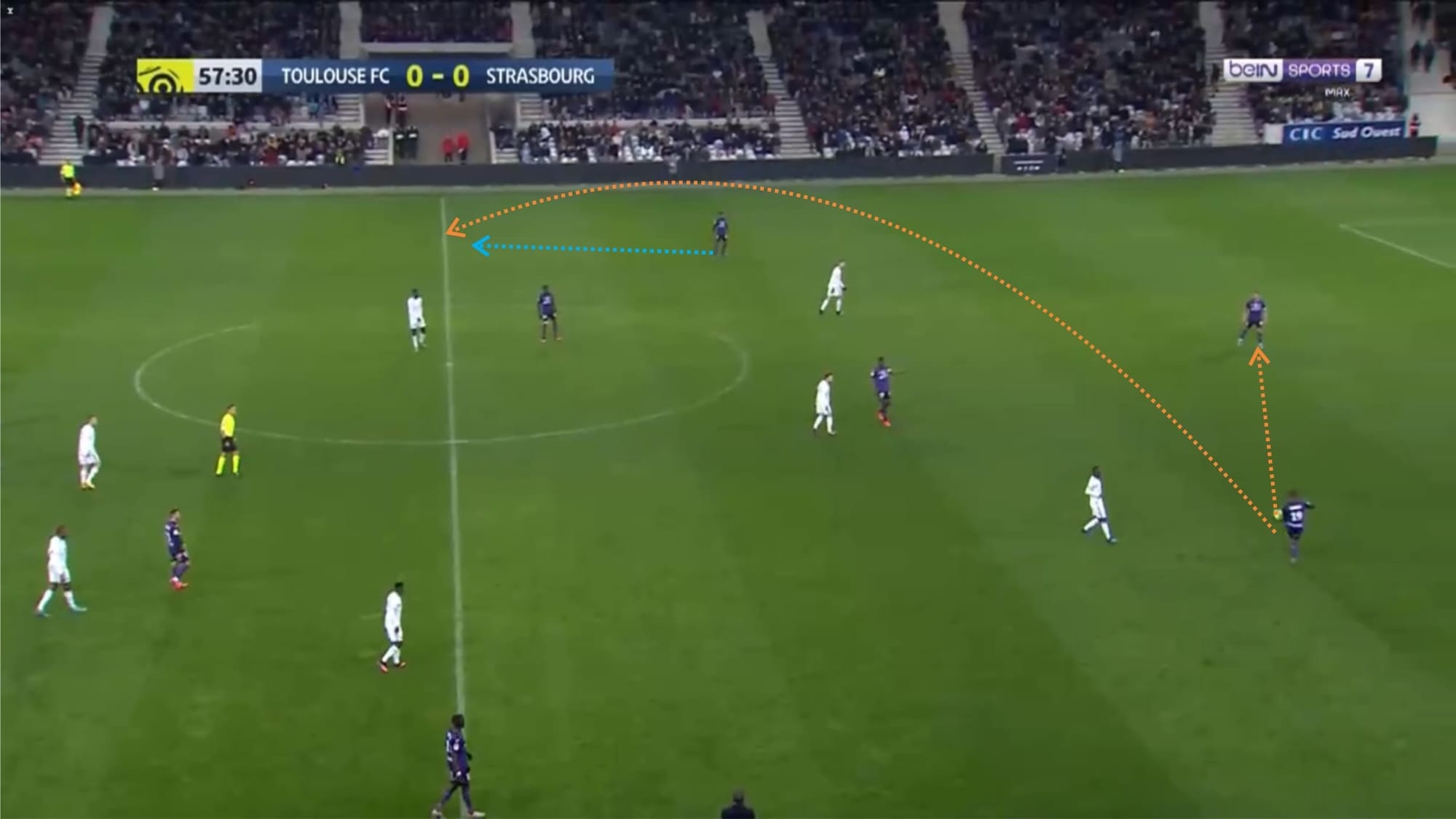
Mainly Diakité prefers to play short or medium-range passes into the feet of his teammate and only occasionally attempts long diagonal or straight passes either towards his teammate or into space. In the image above for example, Diakité chose to play a lateral ball towards his partner at the back instead of pinging the ball into space in front of his teammate on the flank although that area seemed free. This doesn’t seem to be because of a lack of vision
His tendency can also be seen in these pass maps below.
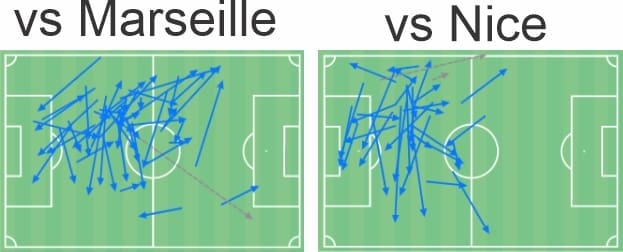
In the two matches above, Diakité played as a left-sided centre-back. As you can see, most of his passes consist of short or medium-range passes. He tends to aim it laterally, playing the ball towards his partner though often he’ll also look to play short-medium progressive passes himself aimed mainly at the near full-back or an oncoming midfielder. He doesn’t seem brave enough to attempt risky passes like playing the ball towards a player in between the lines. Long balls aimed at the striker or to switch play (like in the previous image) are also rare. When under pressure, Diakité mostly would look for a short, safe option or a backpass instead of driving forward and beating his man or playing the ball long.
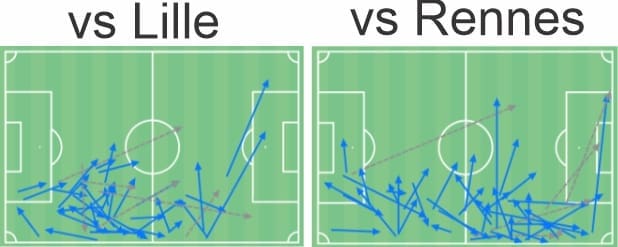
In the images above Diakité played as a right-back. As you can see, the 19-year-old defender also tends to play the ball short and rarely attempts long pass whether it’s aimed into space upfront or towards the striker or towards the opposite side of the pitch.
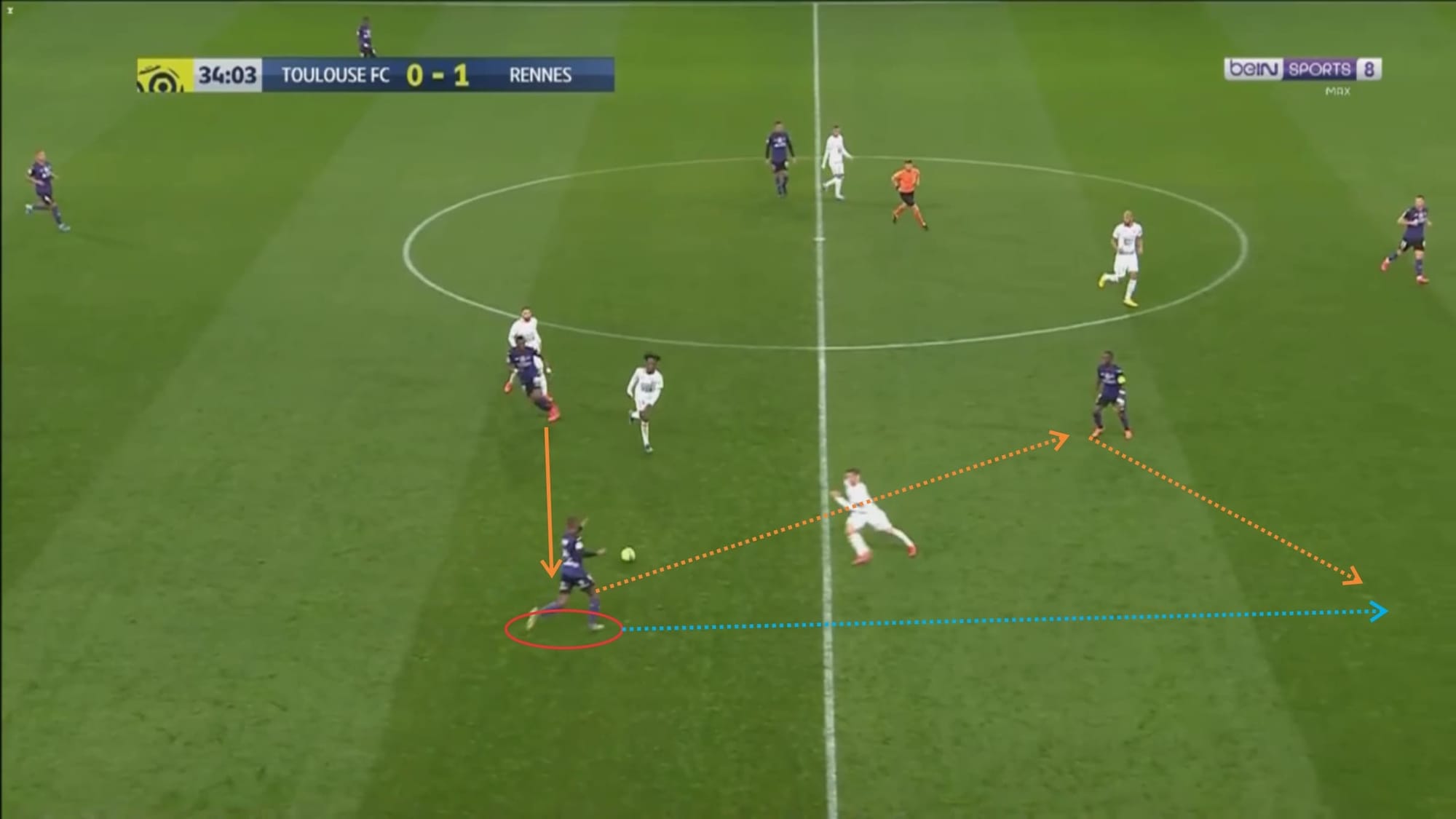
As a right-back, Diakité often looks to exchange quick one-two touch short-pass combinations as in the image above. After receiving a pass from the central midfielder, Diakité quickly passed it towards his teammate (Max Gradel) and advanced forward to exploit space left by his presser. Gradel then returned the pass into the feet of Diakité.
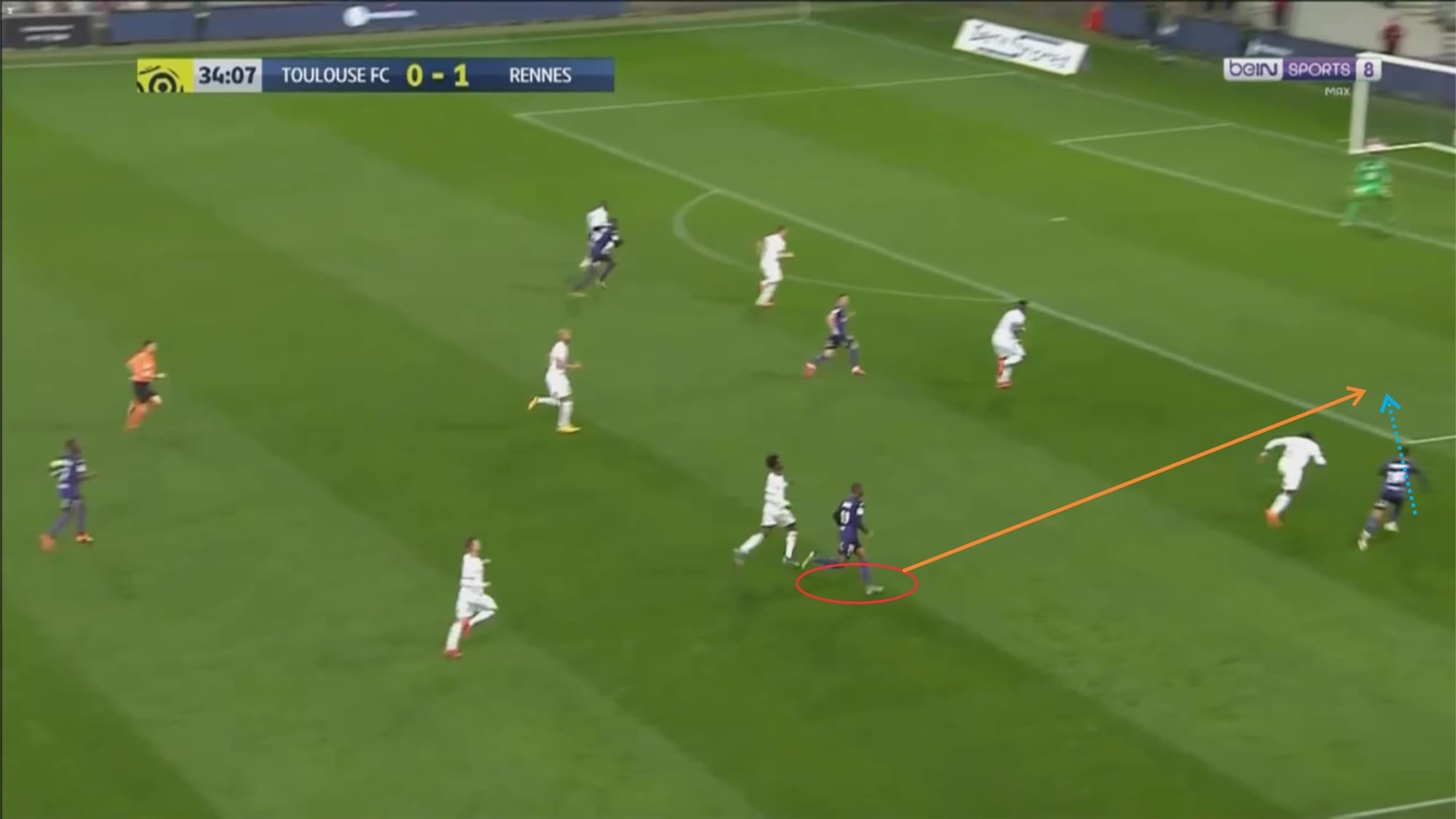
Upon receiving the return pass, Diakité carried the ball over short distance waiting for the right moment before then releasing a through pass into space in front of the right-winger.
Diakité is rather inconsistent, however. At certain times, Diakité seems to be a bit more brave and confident as well as creative with his passes as he can be seen playing passes into space in the back of the opposing team’s defence more often than usual but some other times he lacks confidence and bravery to take a risk and play difficult passes despite having an opportunity to do so, preferring to be more cautious and play safer passes thus limiting his passing pattern.
His execution is also not quite perfect yet. He does show his ability to find the runs of his teammates and space to move the ball into, but it seems that at times the execution and timing are rather poor. Oftentimes his passes are either underhit or overhit, which can cause panic and trouble at the back, especially as he often attempts backpass towards the goalkeeper.
Statistically, Diakité averages 38.62 passes per game with a success rate of 88.1% which is pretty decent for a player who usually has a lot of time and space at the back and mainly plays safe passes. Diakité also averages 15.29 progressive passes per game with a success rate of 77.9%. The high success rate can be linked again to his tendency to play short-medium progressive passes towards easy, obvious options rather than playing difficult risky progressive but potentially high reward passes. Diakité also records an average of 3.16 long passes per game with a success rate of 44.1%.
Crossing is certainly not his forté as well. When playing as a right-back, Diakité doesn’t always advance forward and rarely attempts crosses whether it is from deep or from the byline. He mainly prefers short combinations as seen in the images above and relies on the winger instead to deliver crosses. Statistically, Diakité only attempts an average of 0.38 crosses per game with a success rate of 42.9%.
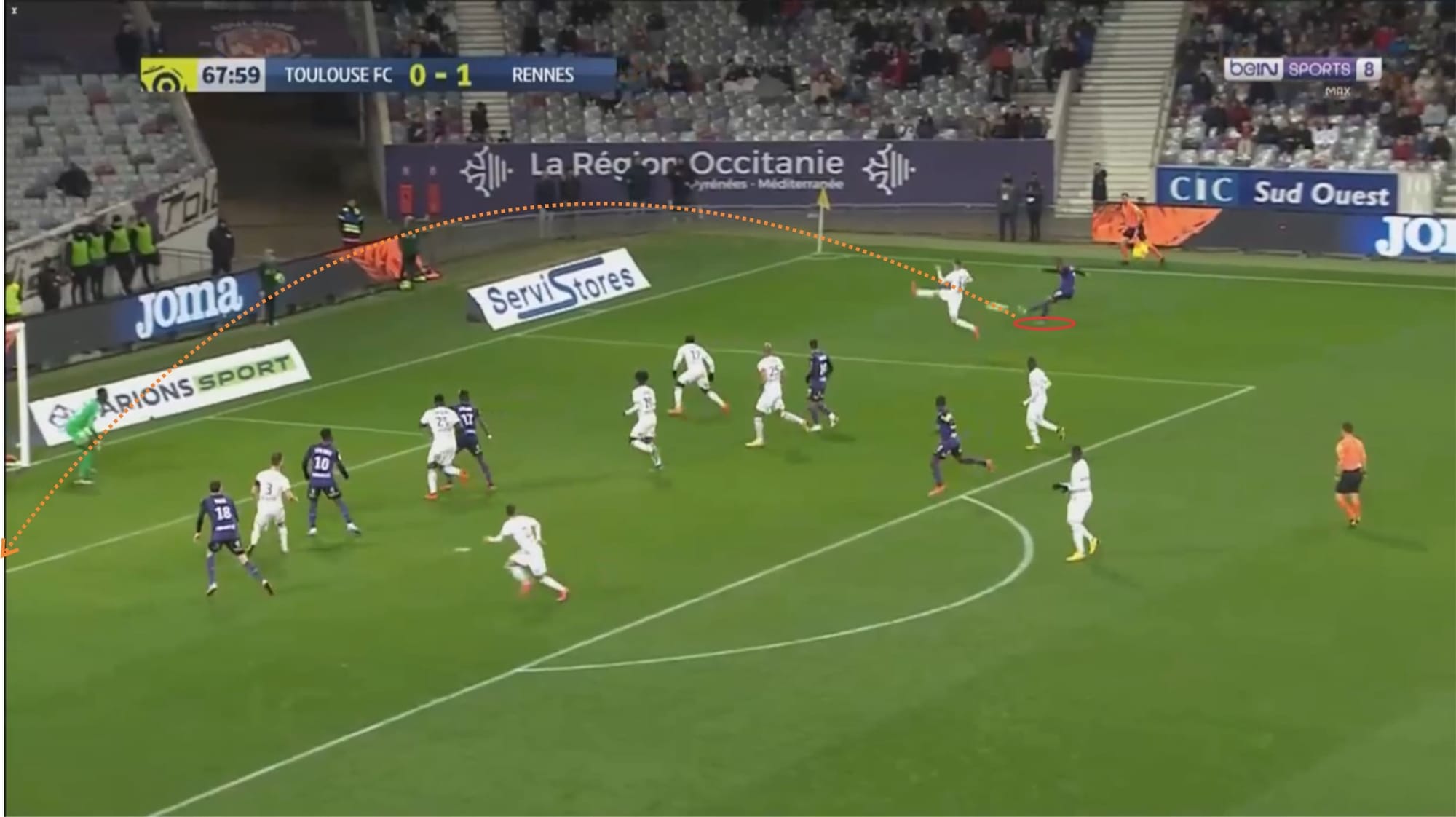
The 2001-born defender tends to deliver a lofted ball towards the far post. His crosses are also often inaccurate and rather easy to intercept due to him overhitting or underhitting them. Linking back to his inability to win 1v1 offensive duels, Diakité’s movements and preparation before hitting his cross can often be read and thus the cross can usually be blocked by his direct opponent.
It’s certainly not the most crucial attribute in his game but if he can improve a little bit in this area, it certainly can give him certain advantages when playing as a right-back.
Defensive skills and tendencies
Toulouse certainly have one of the worst defences in Ligue 1, having 45.81 xGA (second-worst in the league behind Brest) and conceding an incredible 58 goals this season already (most goals conceded in the league). Looking at the way they play though, it can’t be said that their problems are due to the lack of competence of the defenders, but mainly due to the system and tactics they adopt. Playing in a team with this kind of defence certainly affect how people look at Diakité, perhaps thinking he’s also one of the problems. Though he’s certainly not a perfect player and still concedes a few mistakes, he’s one of the few players that stand out in defence this season.
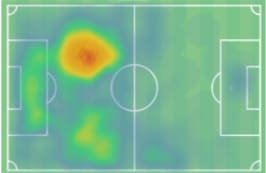
Diakité mainly plays as a left-sided centre-back at Toulouse and only occasionally plays as a right-sided centre-back, playing at a four-man backline mainly in a 4-1-4-1 or 4-4-2 system. A few times this season he has also been deployed as a right-back, occupying a defensive full-back role in that position. As you can see from the heatmap, as a right-back, Diakité mostly sits inside his own half and rarely roams forward and covers the opposing half although at certain occasions – especially when his teammate is in desperate need of support – he’ll look to advance out of his position in order to provide a passing option and a way out of pressure.
As a centre-back, meanwhile, his coverage is limited. Diakité tends to stay in his position and rarely compromises his team’s defensive structure by going out of position to press or to engage in a duel, although when necessary he’ll look to move out of position and defend against a free opponent while his teammate(s) covers his spot.
Toulouse defend mainly using zonal coverage with a narrow shape though they tend to be man-oriented when pressing. At times, the full-backs may temporarily become man-oriented as they stick close to the winger they are defending against if the ball is on the flank. Meanwhile, both centre-backs usually maintain their positions and rarely get dragged out by opposing attackers who drop to receive. Though by doing so they can maintain their shape and structure as well as preventing an opening at the back of the defence, at times, this can lead to an opposing player being able to receive the ball in front of the defence, in between the midfield and defensive lines.
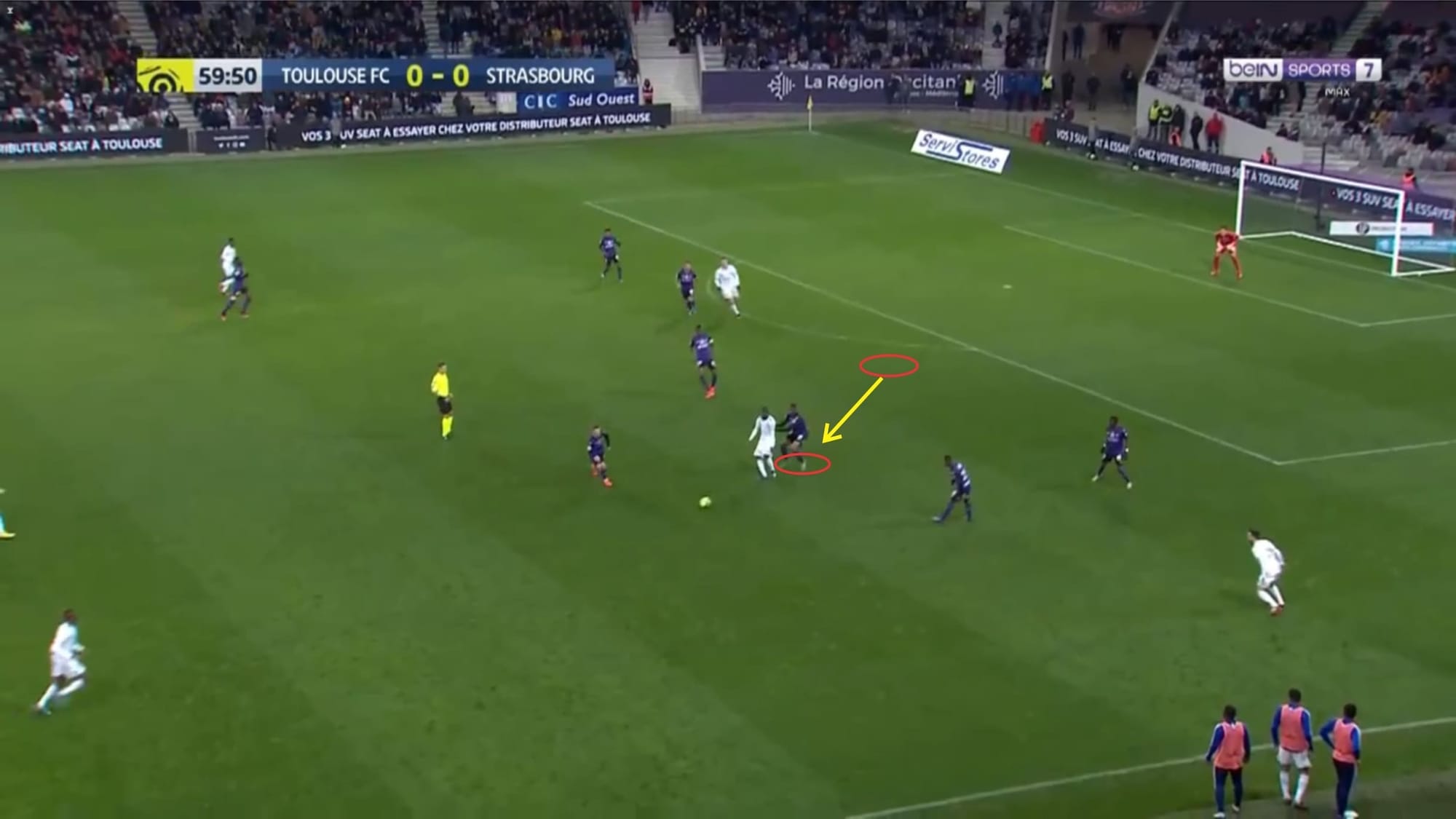
Usually, Diakité tends not to stick very tightly and follow his opponent whilst leaving his position, but when the ball is played towards his man, he’ll quickly and aggressively close him down, not allowing him to turn and restricting time and space which in turn limits his options. His speed is on display in the image above as he’s able to quickly accelerate and cover the distance to close down his opponent to restrict his movements and limit his options without having to strictly stay close with him. His ability to read the game is pretty decent which is shown by his tendency to react quickly and position himself in the right positions most of the times.
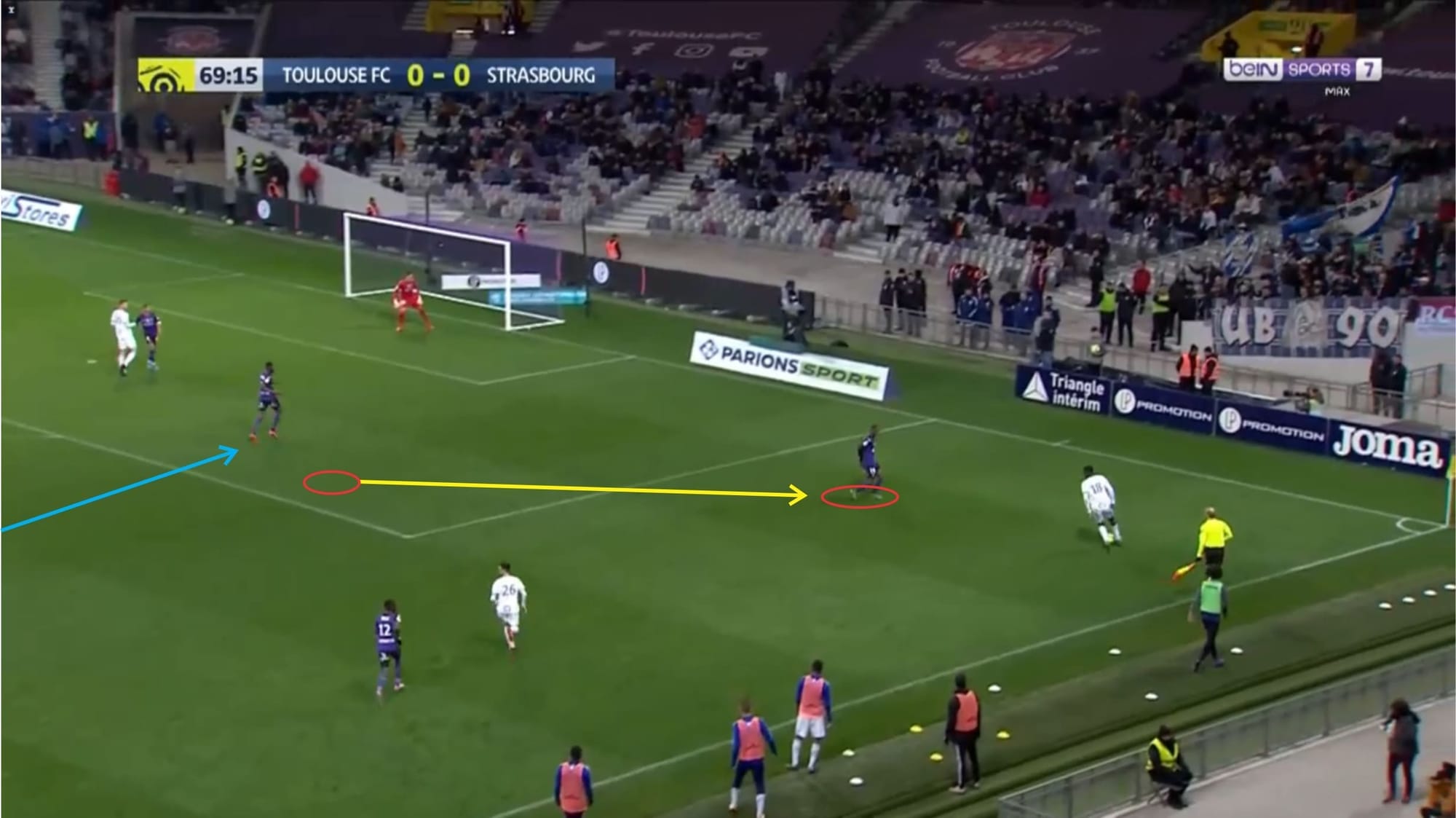
Occasionally, Diakité also looks to cover deep wide areas in case his full-back is caught out of position, thus leaving his spot as can be seen in the image above. With the full-back nowhere to be seen, Diakité had to step up and cover that space instead of staying in his spot and letting the opposing ball carrier cross the ball freely which can be very dangerous. In this case, Diakité realised that his position was closer to the ball carrier and knowing that he had a defensive midfielder close by that could cover his spot, Diakité felt safe to move out of position and engage his opponent in a 1v1 duel.
He seemed to be quite a vocal player, having a good understanding and actively communicating with his teammates. This can be seen by him often pointing fingers and telling his teammates to push forward (to trap an opponent offside) or to cover an area or mark an opponent.
Diakité is quite solid in 1v1 defensive duels and tackling. As mentioned in the previous section, Diakité possesses great strength and can outmuscle his opponents in physical duels and his off-the-ball agility, as well as, quickness helps him a lot when facing quick opponents making him quite difficult to beat on the turn.
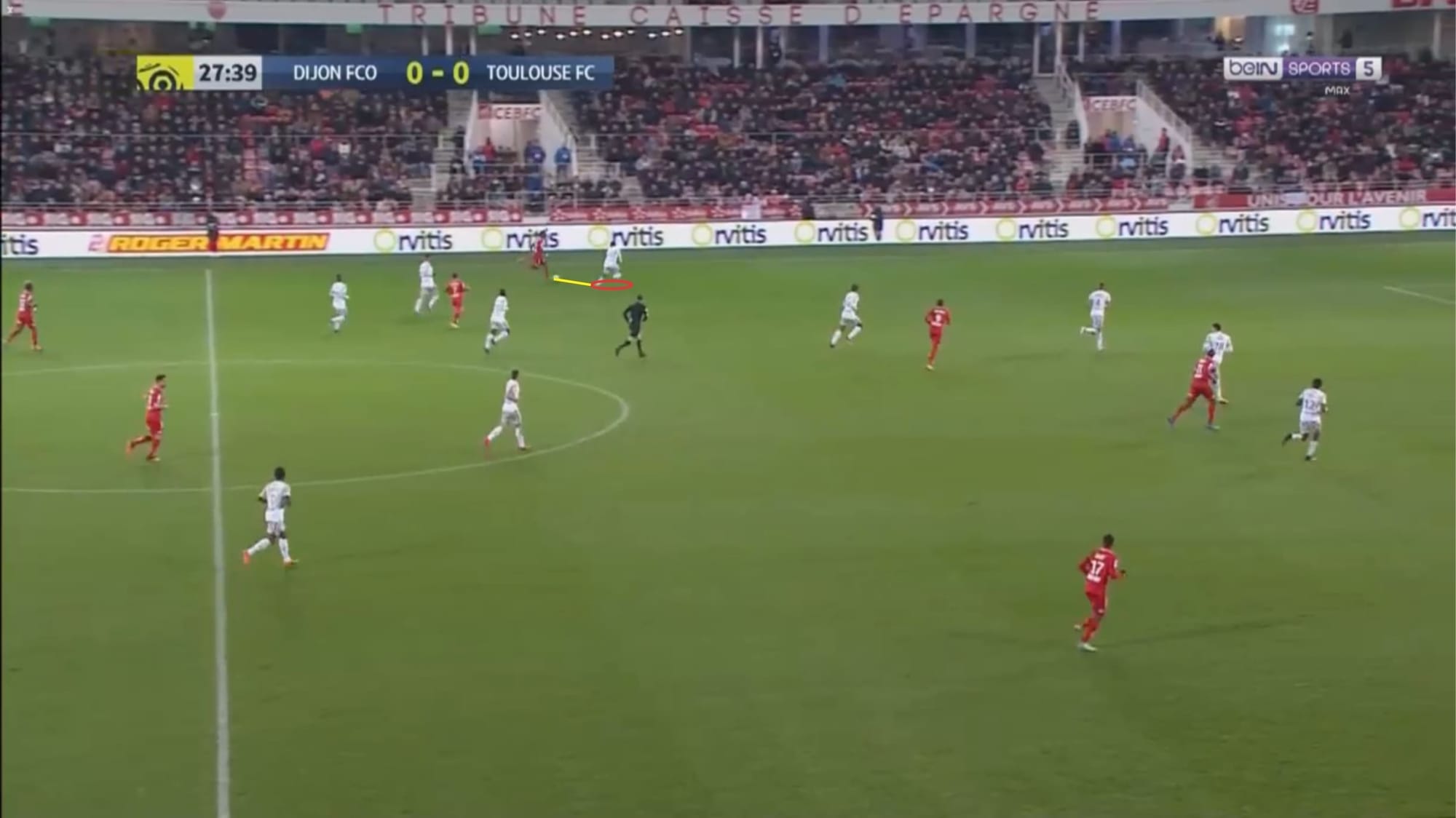
Diakité is usually quite patient in 1v1 duels, mainly just looking to shadow his opponent’s movements whilst slowly edging closer and restricting space as well as limiting his options and forcing him to make a decision. Once he finds opportunity and momentum to win the ball, he’ll stick his leg out and commit a tackle. In the image above, for example, Diakité quickly closed the opposing winger down once the ball was played towards him. He didn’t face his attacker head-on but sideways, steering him wide and limiting his room of movements. With his teammates marking the near options, the opposing ball carrier was effectively isolated.
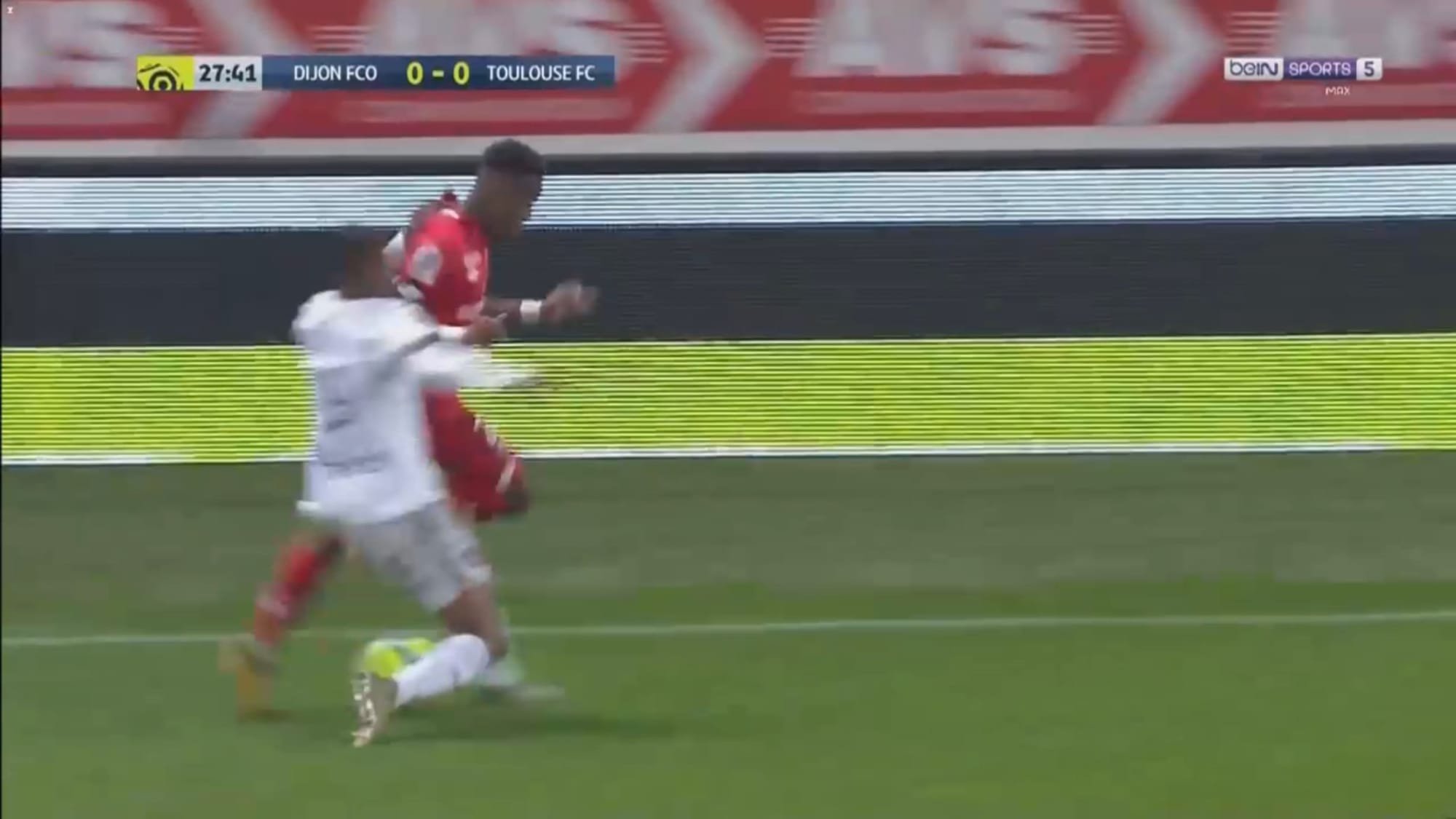
In this situation, the opposing winger had pretty much nowhere to go but to run along the touchline and try to beat Diakité. The defender, meanwhile, waited until his opponent knocked the ball away before sticking his leg out and recovering the ball.
Diakité doesn’t seem to have a tendency to lead his tackles with one particular foot and is able to use either foot comfortably to lead his tackles making him quite flexible and strong on both sides.
Diakité is quite solid in defence but there are certainly still a few things he’ll need to improve. Firstly his tendency to lose track of his opponent due to lack of concentration and awareness seems to be quite a prominent problem of his. This seems to be mainly due to his poor body orientation as well as lack of scanning/checking which results in lack of perception or information regarding his surroundings.
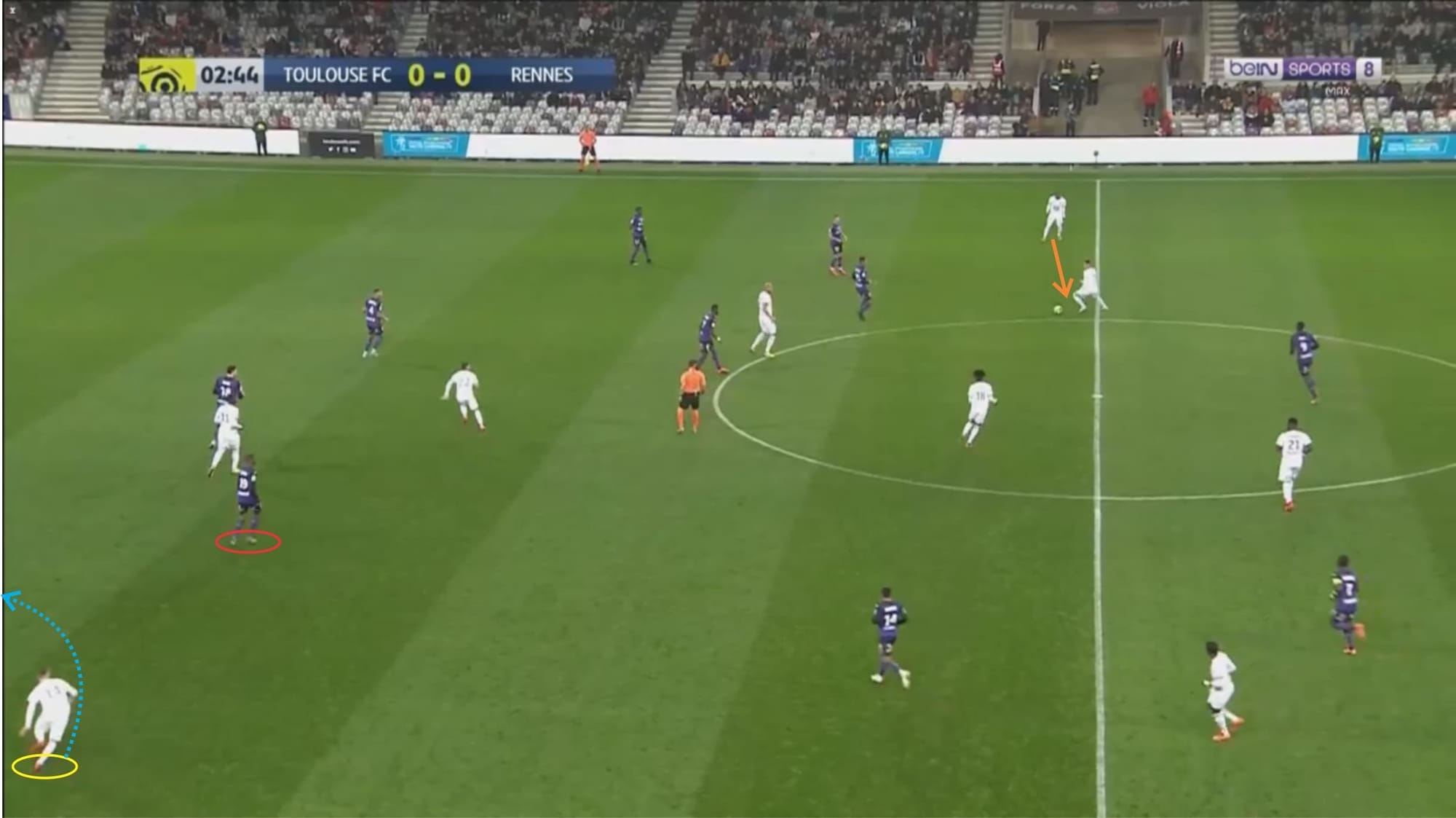
Above, for example, he’s in a closed shape and didn’t see an opponent sneaking down the flank.
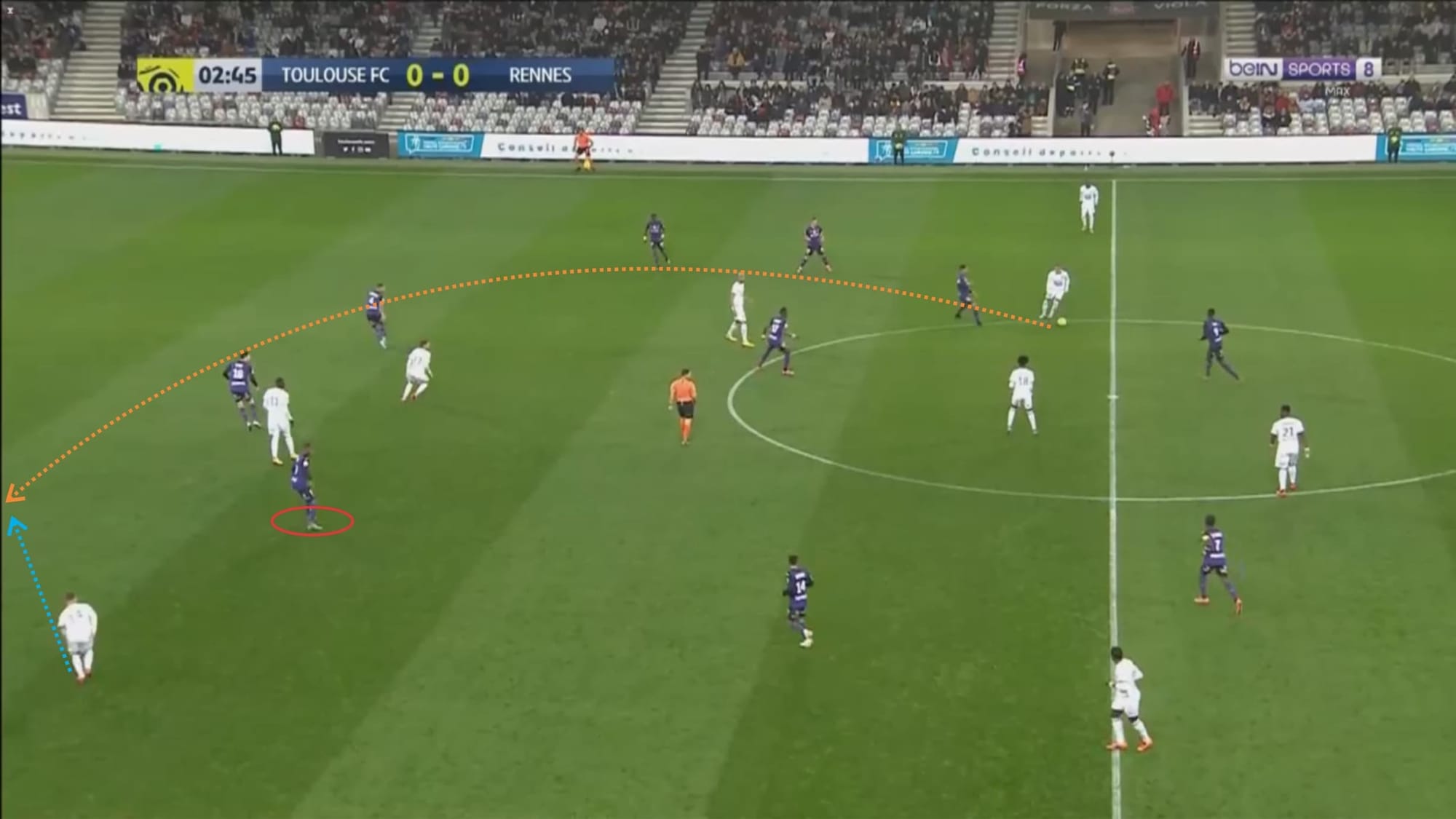
Just as the ball carrier was about to play a pass towards the space behind the defence, Diakité fixed his body position and stood in an open shape. He also turned his head and noticed the left-winger of the opposing team making a run into space.
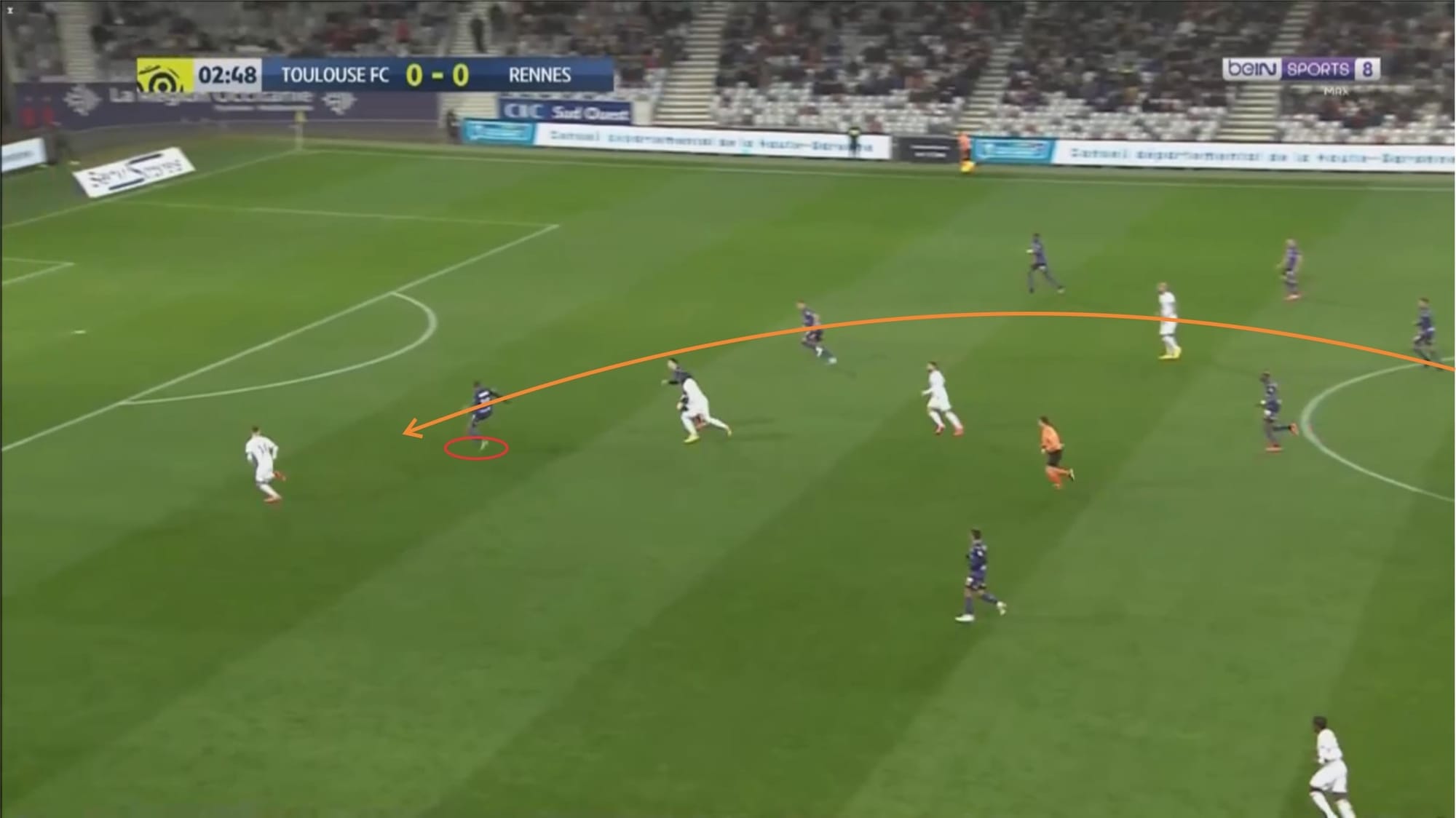
Though his reaction to the situation was a bit late and could have been quicker, he managed to compensate that with his agility and ability to quickly cover space. In this particular situation, however, despite managing to stick his leg out to try and intercept the ball, Diakité missed the interception and as a result, the opposing winger managed to receive the ball and score a goal. It was a poor display by the young defender, showing his lack of awareness and concentration.
Aside from that, his poor decision making can also cost him and his team dearly.
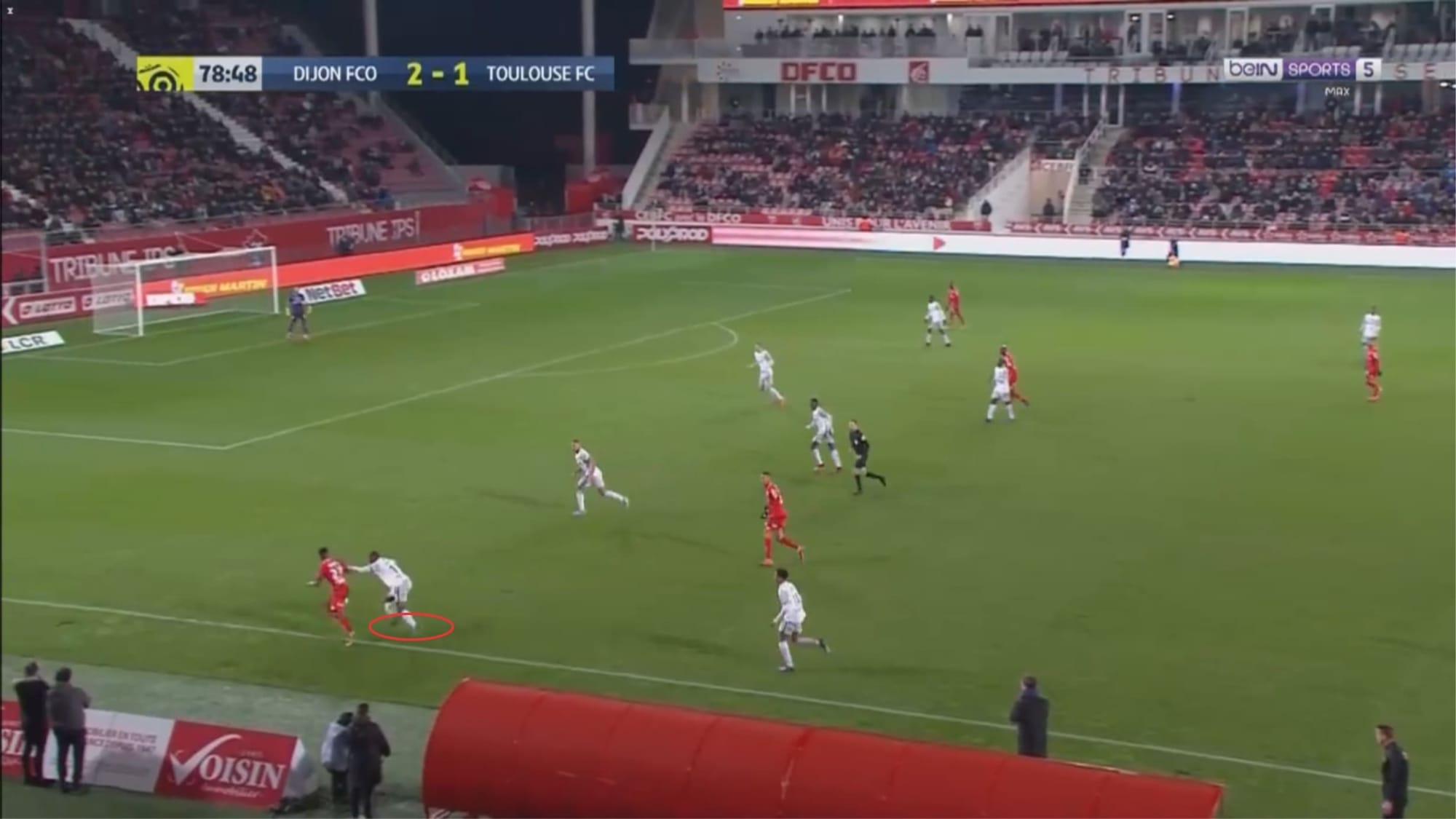
Though it is mentioned before that Diakité is usually patient in 1v1 defensive duels, sometimes he feels confident that he can win the ball and commit to the ball early instead of waiting for momentum and opportunity. The image above, for example, Hamza Mendyl of Dijon managed to beat Diakité when the Toulouse right-back aggressively closed him down and stuck out a leg to try to win the ball. Though this doesn’t regularly happen, it does happen a few times in every game, making it quite a visible vulnerability of him.
Conclusion
Despite playing in a team that have been very disappointing this season both offensively and defensively, Diakité is among the highest-rated U20 centre-backs this season in Ligue 1. And though he’s certainly not as popular as, for example, Tanguy Kouassi of Paris Saint-Germain, he certainly has shown a lot this season and can be a huge asset for France in the future if developed properly.
The Toulouse-born defender’s impressive performance this season has captured the attention of several clubs outside in Ligue 1 as well as outside of France including Napoli in Serie A. At the moment, it seems like getting a good amount of game time is much more important for the defender knowing that he’s still a raw talent and there’s still so much more to improve before he’s ready to make a big step up though he certainly shows high potential.





Comments